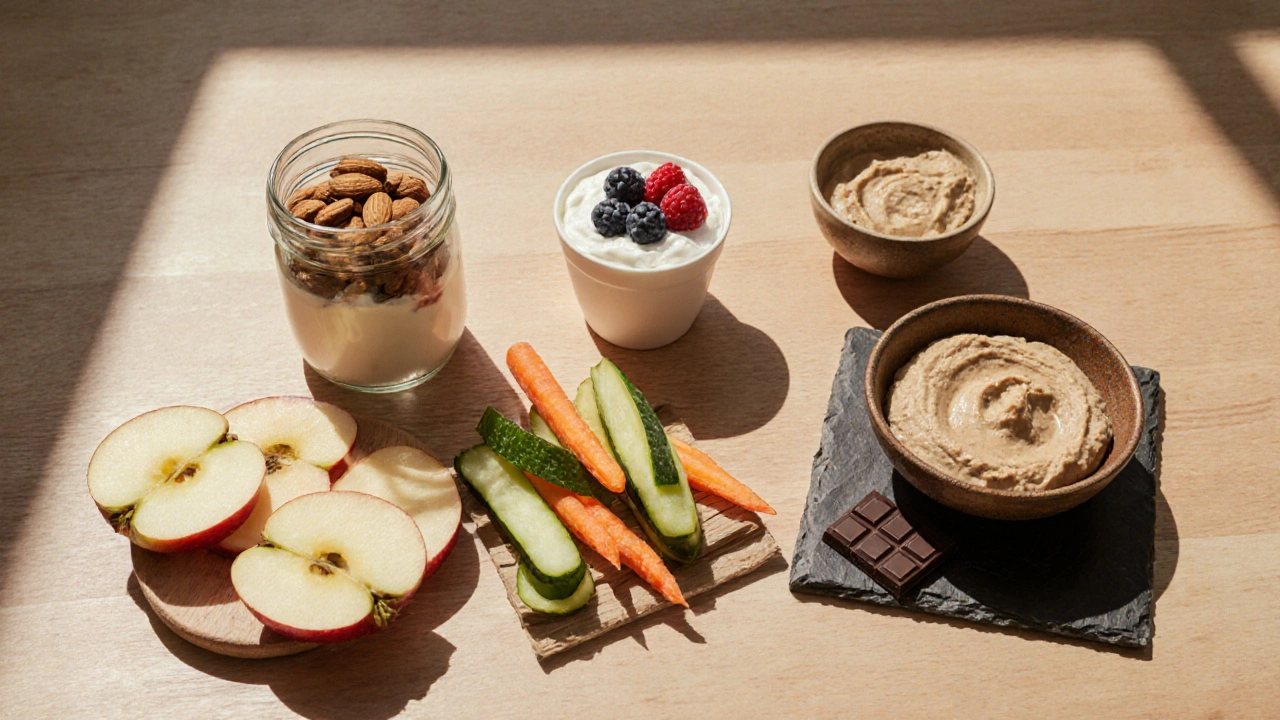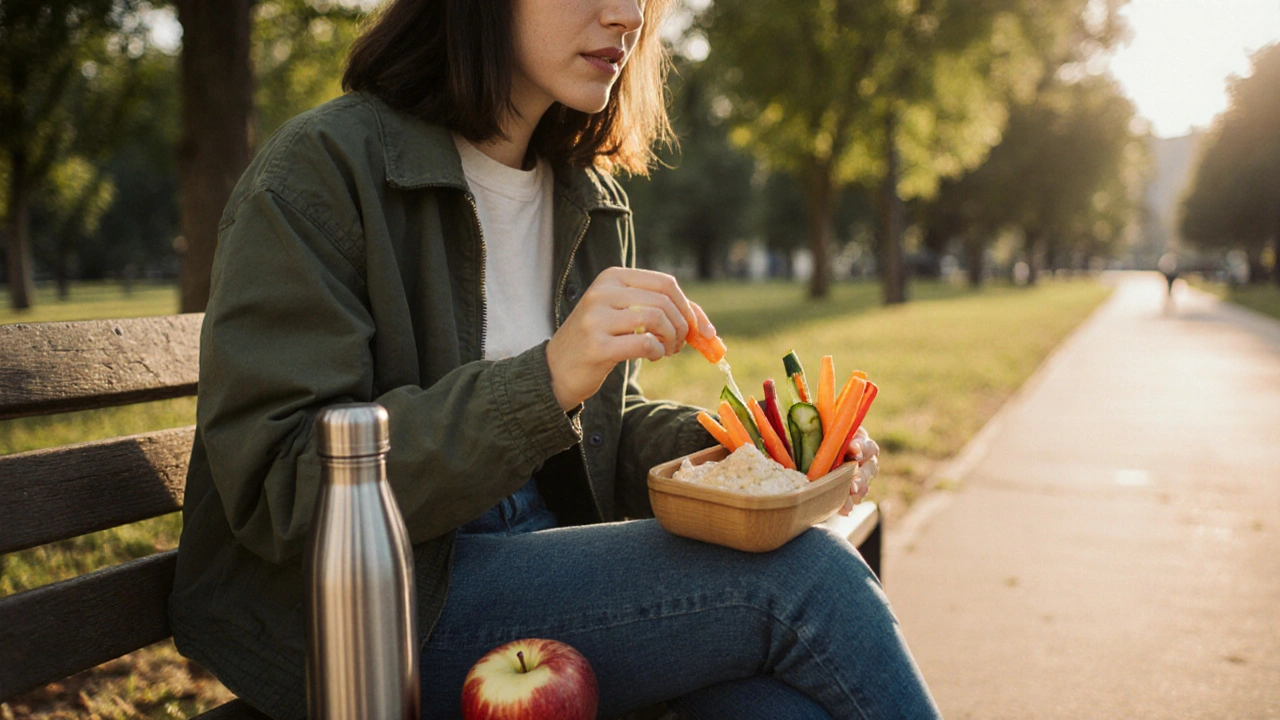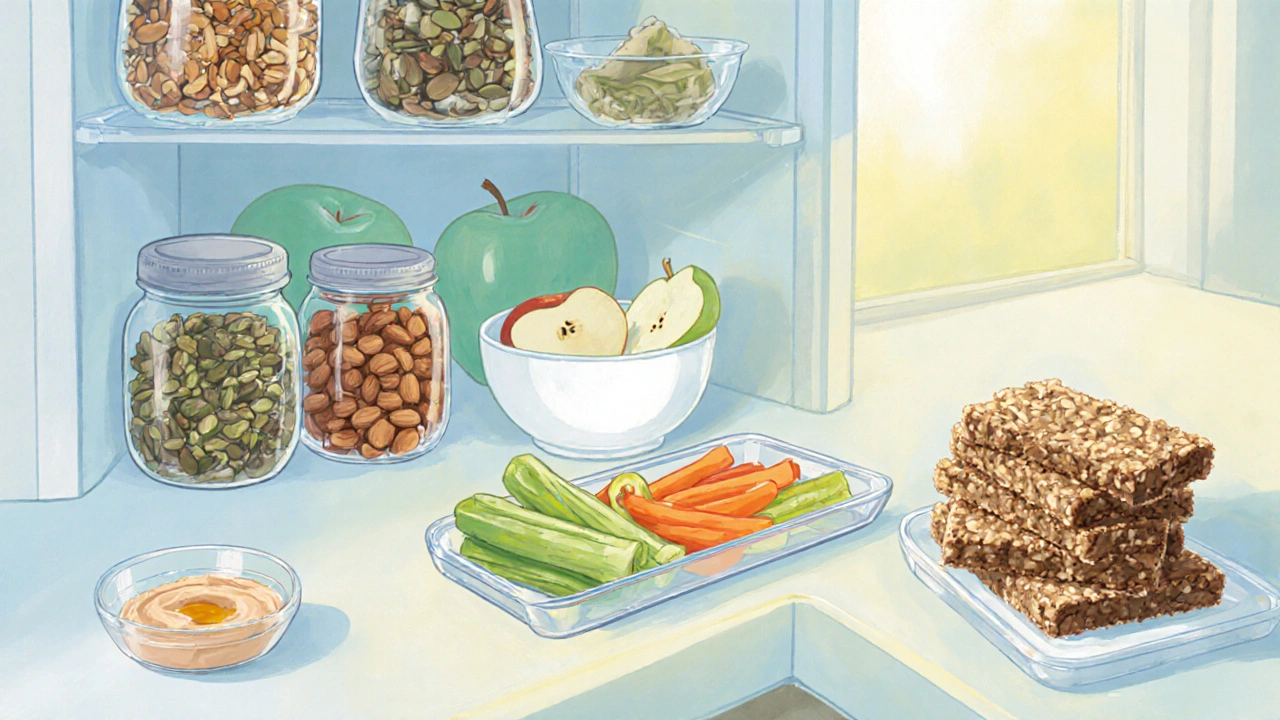
Healthy Snack Selector
Recommended Snacks
Key Takeaways
- Choosing snacks rich in protein, fiber, and healthy fats keeps blood sugar steady.
- Whole fruits, nuts, Greek yogurt, and hummus top the list for quick, portable options.
- Portion control is essential - think 1‑hand‑ful of nuts, 1 medium fruit, or ½ cup of dip.
- Prep ahead: wash veg, portion nuts, and grab a pre‑made yogurt cup for stress‑free snacking.
- Watch hidden sugars and excess sodium; read labels carefully.
When you reach for a bite between meals, a healthy snack is a small portion of nutrient‑dense food that supports energy, mood, and weight goals.
Why healthy snacks matter for a balanced life
Skipping meals or grabbing a sugary bar spikes insulin, leading to a crash an hour later. A well‑chosen snack supplies steady glucose, which fuels brain cells and muscles. Research from the Nutrition Society (2024) shows adults who include protein‑rich snacks report 15 % higher satiety scores and 10 % less overall calorie intake.
Beyond calories, the right snack can deliver vitamins, minerals, and antioxidants that protect heart health and gut bacteria. For example, a handful of almonds provides vitamin E and magnesium, both linked to lower blood pressure.
How to pick a snack that works for you
Use three quick criteria:
- Macronutrient balance: aim for at least 3 g of protein and 3 g of fiber per serving.
- Portion size: keep calories between 100‑200 for most people; athletes may need more.
- Minimal processing: choose foods with fewer than five ingredients and no added sugars.

Top snack categories, defined
Below are the most versatile groups, each introduced with a short definition.
Whole fruit is a fresh, unprocessed produce item that contains natural sugars, fiber, vitamins, and antioxidants.
Nuts and seeds are edible kernels rich in healthy fats, protein, and minerals such as magnesium and zinc.
Greek yogurt is a strained dairy product that delivers twice the protein of regular yogurt and a good dose of calcium.
Hummus is a chickpea‑based dip blended with olive oil, tahini, lemon, and garlic, offering fiber and plant‑based protein.
Veggie sticks are raw vegetables cut into bite‑size pieces, providing crunch, water, and micronutrients.
Dark chocolate is cocoa solids with at least 70 % cacao, supplying flavonoids that support heart health.
Granola bar is a compact mixture of oats, nuts, dried fruit, and binder, designed for on‑the‑go energy.
Quick‑reference nutrition comparison
| Snack | Calories | Protein (g) | Fiber (g) | Best time |
|---|---|---|---|---|
| Apple (medium) | 95 | 0.5 | 4.4 | Morning |
| Almonds (1hand‑full) | 160 | 6 | 3.5 | Mid‑afternoon |
| Greek yogurt (½cup) | 80 | 10 | 0 | Post‑workout |
| Hummus (¼cup)+Carrot sticks | 120 | 4 | 5 | Anytime |
| Dark chocolate (1sqin) | 70 | 1 | 1 | Evening (moderation) |
| Homemade granola bar | 150 | 5 | 3 | Pre‑hike |
7 go‑to snack ideas you can grab today
- Apple slices with almond butter - 1 medium apple + 1tbsp almond butter gives about 200 cal, 5 g protein, and 5 g fiber.
- Greek yogurt parfait - Layer ½cup plain Greek yogurt, a handful of berries, and a drizzle of honey (optional) for a creamy treat.
- Veggie sticks & hummus - Carrot, cucumber, and bell pepper sticks with ¼cup hummus keep you full for 2‑3 hours.
- Trail mix - Combine almonds, walnuts, pumpkin seeds, and a few dried cranberries; portion into ¼‑cup bags.
- Banana‑cocoa smoothie - Blend 1 banana, ½cup almond milk, 1tbsp cocoa powder, and a scoop of whey protein for a quick post‑run snack.
- Dark chocolate‑nut clusters - Melt 70 % chocolate, stir in a handful of nuts, drop onto parchment, cool.
- Homemade oat‑nut bars - Mix rolled oats, peanut butter, honey, and chopped nuts; press into a pan, chill, slice.

Prep and stock like a pro
Set aside 20minutes on a Sunday to wash, cut, and portion. Store veg sticks in airtight containers with a splash of water to stay crisp. Keep a small jar of mixed nuts on the counter for easy reach. Choose single‑serve Greek yogurt cups or pre‑portion the plain yogurt into small containers.
When shopping, use the “5‑ingredient rule”: if a snack has more than five components, it’s likely highly processed. Scan nutrition labels for added sugars (look for words like sucrose, high‑fructose corn syrup) and sodium over 200mg per serving.
Avoid common snacking pitfalls
- Hidden sugars: Fruit‑flavored yogurts, granola bars, and flavored nuts often contain 10‑15g of added sugar per pack.
- Portion creep: Eating straight from the bag removes visual cues; pre‑bag servings restore control.
- Skipping protein: Snacks lacking protein lead to faster hunger return, prompting overeating at the next meal.
- Skipping vegetables: Relying only on fruit and nuts may leave you short on fiber and certain micronutrients.
Putting it all together - your snack plan blueprint
Follow this simple weekly template:
- Monday‑Wednesday: fruit + nut butter in the morning; Greek yogurt mid‑day.
- Thursday‑Friday: veggie sticks + hummus; dark chocolate after dinner.
- Weekend: homemade granola bars for hikes; smoothie for post‑exercise recovery.
Adjust portions based based on activity level - athletes may double the protein portion, while sedentary days stay at the lower end.
Frequently Asked Questions
What’s a good portion size for nuts?
A typical serving is about 1hand‑full, roughly 28grams or 23 almonds. This provides 160calories, 6g protein, and healthy fats.
Can I snack on fruit if I’m watching carbs?
Yes. Choose lower‑glycemic options like berries, green apples, or kiwi, and keep servings to one medium piece or a cup of mixed berries.
Is Greek yogurt better than regular yogurt?
Greek yogurt has about twice the protein and half the sugar of regular yogurt, making it more satiating and better for muscle repair.
How can I keep veggie sticks fresh?
Store them in a sealed container with a thin layer of water at the bottom; this maintains crunch for up to 5days in the fridge.
What’s the best time to eat dark chocolate?
A small piece (about 1sqin) after dinner can satisfy sweet cravings without spiking blood sugar, thanks to its low glycemic impact.





